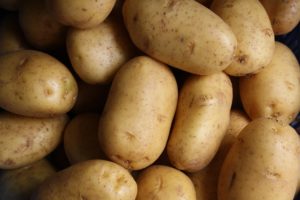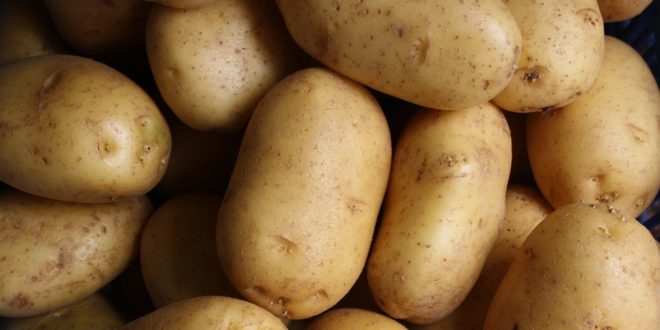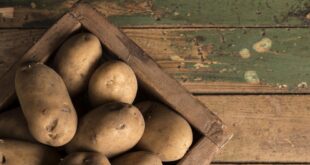 Moving into a smaller home often means having less (or no) space for a garden – not something that sits easily with those of us who enjoy growing our own new potatoes. However, with our cheat’s guide to growing spuds, you can garden almost anywhere – even on concrete! Unlike the careful layering required to establish a no-dig garden, our method is so simple, your harvest will astonish you – and with the spud-sowing season just around the corner, now is the time to prepare.
Moving into a smaller home often means having less (or no) space for a garden – not something that sits easily with those of us who enjoy growing our own new potatoes. However, with our cheat’s guide to growing spuds, you can garden almost anywhere – even on concrete! Unlike the careful layering required to establish a no-dig garden, our method is so simple, your harvest will astonish you – and with the spud-sowing season just around the corner, now is the time to prepare.
Getting started
A cheat’s potato garden can be laid down for the growing season and picked up again once the potatoes are harvested. The garden can be made on concrete, brick, stones, pavers or lawn; on top of a patch of weedy waste ground or on an existing garden bed. The surface does not need to be level – a gentle slope, uneven; or undulating surface is fine. (Bear in mind, however, that the area will remain damp for a number of months, and that during that time, leaching will occur which may discolour the underlying surface.)
Choose a moisture-retaining underlay to cover your chosen garden patch (an old piece of woollen carpet is ideal but you can also use a 2-3cm layer of old duvets, towels, blankets, curtains, cardboard or newspaper.
Next, toss down on top of your underlay a 20-30cm layer of loose organic material. This is your growing medium, and it’s where the fun begins because if you’re a forager, it can almost always be gathered free of charge. Fallen leaves, rotting balage, pea straw, wheat or barley straw (or any of the aforementioned combined with lawn clippings or untreated wood shavings and untreated sawdust) are all ideal growing mediums and can often be collected free from sawmills, or parks and gardens after a quick phone call to your local council for permission
Add nutrients
Potatoes carry their store of food inside the tuber they grow from. However, by adding a little nutrient to your growing medium, you’ll help the plants to grow more vigorously and be more productive. The nutrient can be blood and bone, well-made compost, rotted animal manure, all-purpose fertilizer or some superphosphate. Whatever you decide to use, ensure its appropriate for the situation you are growing in (if you’ve decided to build a cheat’s garden on a section of your small concreted backyard, for example, all-purpose commercial garden fertilizer will be more suitable than animal manure which may cause an unpleasant odour and dark leaching). Once you’ve decided on your nutrient, scatter it onto the growing medium and stir it in so that it won’t be in direct contact with the seed potatoes you’ll be planting on top of it. Wet the growing medium thoroughly with water.
Sow
Cheat’s potatoes can be sown a little closer together than soil-sown potatoes as the growing medium is loose textured which promotes fast developing tubers. Sow the seed potatoes 20-30cm apart and cover them with about 30cm of growing medium. There is no need to add growing medium as the plants develop but, if you have some on hand, there is no harm in piling it around the stems, and you may get a slightly greater harvest as a result.
Watch and water
Cheat’s potato plants require more regular watering than soil-grown potatoes as the growing medium is above ground level and very free-draining. In dry conditions, water the garden daily or whenever you see the potato tops wilting. You need do nothing else but wait for your harvest to develop.
Harvesting
Contrary to popular belief, post-flowering is not always an indication of when potatoes are ready to harvest. Instead, be guided by the length of growing season for the given variety you are sowing. The loose growing medium used in the cheat’s growing method makes it easy to ‘tickle’ a plant to see if the tubers are large enough to harvest. When they are, simply lift off the growing medium to expose the potatoes – no digging is required! They harvest will also be much cleaner than soil-grown potatoes, and easy to wash prior to using.
Pick up and pack away
Once your potatoes have been harvested, simply compost the growing medium or (if you don’t have space to do this) place it in your green waste recycling bin. Cloth or carpet underlay can be discarded, or dried and stored for use the following year. What was previously your garden space is now available for its original purpose. Cheats potato growing couldn’t be simpler or more productive – and it’s so much fun!









Join the Discussion
Type out your comment here:
You must be logged in to post a comment.